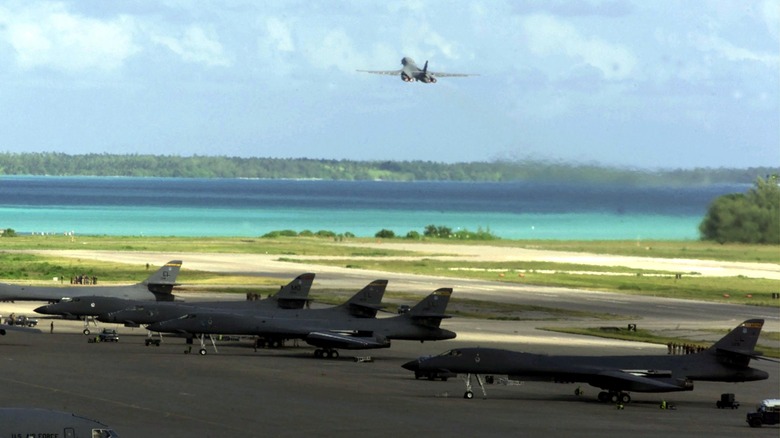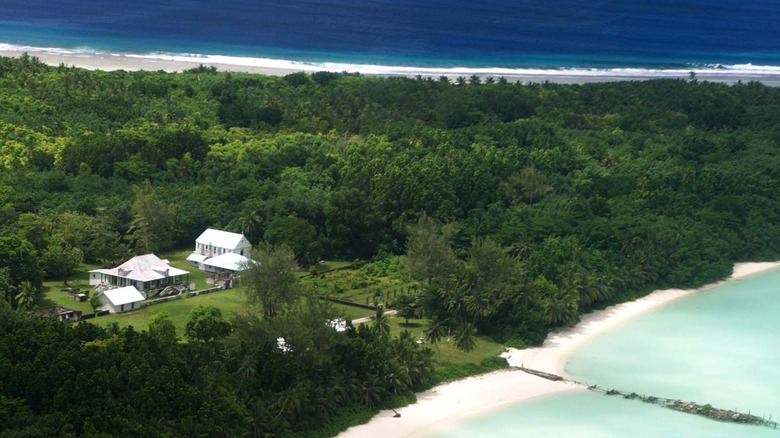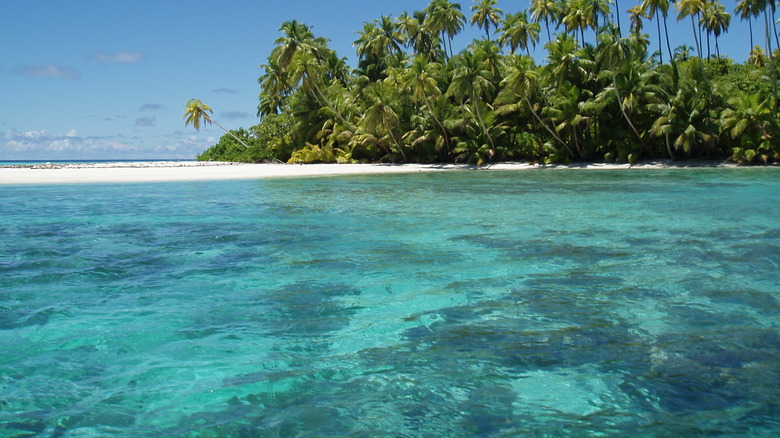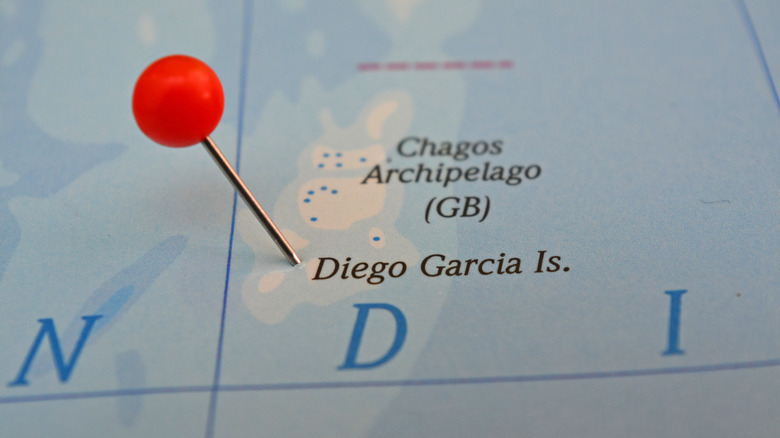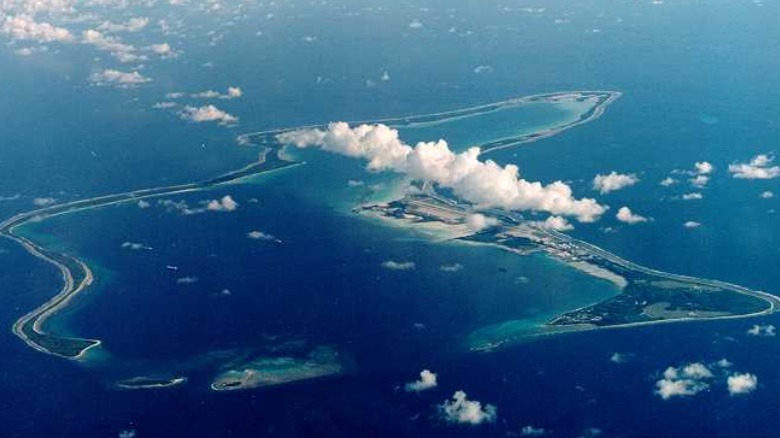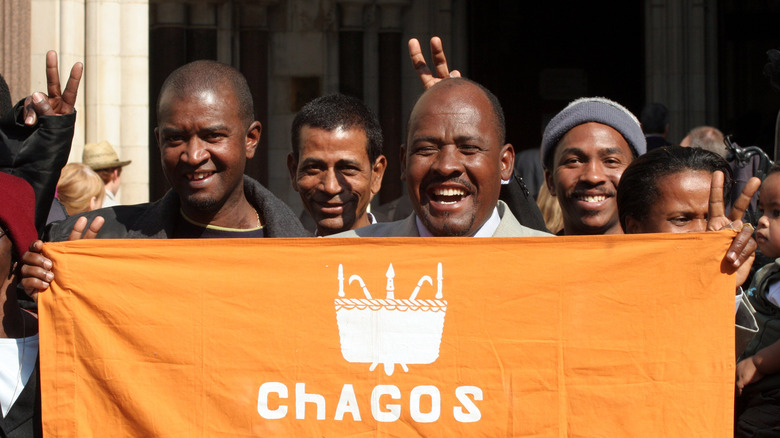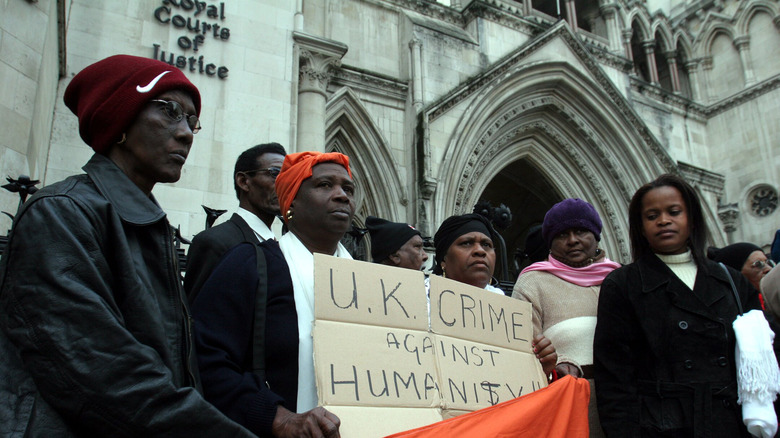This Is The Real Reason The U.S. Expelled The Chagossians From Their Island
The United States military considers the Chagos Archipelago in the central Indian Ocean an ideal location for military operations. The U.S. Navy Support Facility at Diego Garcia was used as a staging ground during both the wars in Iraq and Afghanistan and it's also allegedly used by the CIA for rendition flights (per NPR). But before the United States decided to turn the archipelago into a military base, it was the home of thousands of people who had to be forcibly deported to make way for the military.
In order to maintain a global military influence, the United States and the United Kingdom ended up making a deal to completely clear the island of its indigenous inhabitants. One cable from 1966 stated that "there will be no indigenous population except seagulls."
Since their expulsion from the Chagos Archipelago, Chagossians have been fighting for their right to return. But despite everything, as of 2021, the United Kingdom persists in digging in their heels and refusing to allow Chagossians the right to return to their motherland. This is the real reason the U.S. expelled the Chagossians from their island.
Colonization of the Chagos Archipelago
Before the Chagos Archipelago was colonized by Europeans, it was occasionally visited by Maldivian people. However, according to "Folk Tales of the Maldives" by Xavier Romero-Frias, the Chagos Archipelago was considered to be a "remote desolate place" and despite the occasional landings in the Archipelago by southern Maldivians, no permanent settlements were created and the islands were uninhabited.
As a result, the first inhabitants of the Chagos Archipelago arrived during the 18th century in the form of enslaved people when French sugar and coconut plantation owner Sieur Pierre Marie Le Normand was granted a land concession on Diego Garcia, the largest island of the archipelago, to create a coconut plantation. Le Mauricien writes that in 1784, 79 Mozambican and Malagasy enslaved people as well as a few free people of color built and settled Le Norman's coconut plantation. As more coconut plantations were established, more enslaved people were brought to the archipelago. According to The Minority Rights Group Report, "the Chagos islands [also] became a leper colony" as people living with leprosy in Mauritius were banished to the Chagos Islands.
RefWorld writes that in 1814, the British Empire took over the colonial rule of the Chagos Islands and continued to maintain the plantations run on the labor of enslaved people. And when enslavement was abolished in 1835, British plantation owners started instead bringing in people to work as laborers from South Asia. Between 1826 and 1880, the population of the Chagos Archipelago increased from 275 to 760 permanent inhabitants.
Creation of the BIOT
On November 8, 1965, the creation of the British Indian Ocean Territory (BIOT) detached the Chagos Archipelago from Mauritius, creating a new colony. This was done "in response to U.S. military aspirations in the Indian Ocean," and as Republic of Mauritius v. United Kingdom of Great Britain and Northern Ireland notes, the British government falsely described the islands to the United States as having "virtually no permanent inhabitants." And although there were more than 1,360 people living permanently in the archipelago, the two countries came to an agreement to expel the inhabitants from the archipelago.
In December 1966, the U.S. and the U.K. made an Agreement Concerning the Availability for Defense Purposes of the BIOT," which held that although the BIOT was to stay under British rule, it would be made available to "meet the needs of both Governments for defense." Two years later, Mauritius gained its independence and, according to "The Chagos Islanders and International Law" by Stephen Allen, the British Empire essentially granted independence in exchange for the Chagos Islands. In addition, "there was an absence of a meaningful choice on the part of the Mauritian political leadership regarding the terms of the bargain."
Some of the archipelago was privately owned by Chagos-Agalega Ltd. and British officials pressured them to sell for $874,000. Half of Chagos-Agalega Ltd, the firm Moulinie & Co., was also paid to manage the islands for the U.K. by 1968, per "Eviction from the Chagos Islands."
Mass deportations
Part of Moulinie & Co.'s management agreement with the U.K. entailed refusing anyone entry into the Chagos Islands if they didn't have BIOT consent. And when the BIOT ordered that no Chagossians were to be allowed to return to the archipelago in 1968, dozens of Chagossians ended up stranded in Mauritius. According to "Eviction from the Chagos Islands," they were turned away and told "Your island has been sold," left with no ability to even tell their families back in Chagos what had happened.
Over the following few years, the British government (BIOT) and Moulinie & Co. also started reducing the services in the archipelago and as medicine and food started running out, more and more Chagossians left the Chagos archipelago for Mauritius, with the idea of returning once conditions improved. Some people also report "being tricked or coerced into leaving." In "The Impoverishment of Displacement," David Vine also writes that many Chagossians saw "British agents and U.S. soldiers collecting their pet dogs and exterminating them en masse."
The last Chagossians on Diego Garcia were rounded up and deported in 1971. Some went directly to Seychelles or Mauritius but several hundred went to Peros Banhos and Salomon, believing they could stay in the Chagos archipelago. Those who went straight to Seychelles were kept in a literal prison for weeks and by 1973, all the inhabitants of the Chagos archipelago, roughly 2,000 people, had been forcibly deported to Seychelles and Mauritius, per Al Jazeera.
Living in exile
Although the U.K. reportedly gave the Mauritian government $1.4 million in 1972 to provide Chagossians with housing and settlement assistance, many Chagossians say "little of this money ever reached them." According to The Washington Post, Chagossians in Mauritius in 1975 were living in "abject poverty" while repeatedly petitioning the British, American, and Mauritian governments for help.
Vine writes in The Impoverishment of Displacement that in 1978 and 1982, some Chagossians in Mauritius were given compensation from the British government, but this amounted to less than $6,000 per person. And no Chagossian person in Seychelle has ever received any compensation.
Meanwhile, the National Maritime Foundation reported that the United States considered the base "highly valuable" towards monitoring the Soviet Union during the Cold War. Diego Garcia was used to launch air operations and strikes during the Persian Gulf War, the 1998 Iraq War, and 2001 Afghanistan War and went on to become instrumental during the "war on terror."
Although Chagossians in Mauritius gained Mauritian citizenship, those in Seychelles effectively had no citizenship from Seychelles. However, most were still British colonial citizens despite the fact that "British officials hid [this] from them" until the 1980s, when it was revealed through Chagossian activism, per the book "Eviction From the Chagos Islands."
Throughout everything, Chagossians repeatedly held protests and hunger strikes in the effort to return to their home. And in 1997, Chagossians sued the British crown and questioned the legality of their removal from the archipelago.
The right to return
On November 3, 2000, the High Court of London found that the expulsion of the Chagossians from the Chagos Archipelago was illegal. The court ruled for Chagossians to have the right to return to all of Chagos except Diego Garcia, which had been turned into a U.S. Navy Support Facility in 1977, according to Global Security.
In 2001, Chagossians also sued the British government for compensation and money for return and reconstruction. According to The Impoverishment of Displacement, the High Court denied these claims despite acknowledging that Chagossians were "treated shamefully by successive UK governments."
But before Chagossians were able to return, the British Government announced that in the name of Her Majesty the Queen, they were enacting two royal orders that barred any Chagossian from returning to Chagos, Vine writes in "Island of Shame." Court battles waged on throughout the early-aughts, and in 2016 the U.K. Supreme Court upheld the 2008 ruling that Chagossians wouldn't be allowed to go back, the BBC reports.
At the same time, Chagossians also filed class-action lawsuits against the U.S. government and government officials. However, the Federal District Court for D.C dismissed the suit in 2004 and the U.S. Supreme Court denied petitions for further appeal in 2007. According to legal scholar Christian Nauvel, "the deck is (almost impossibly) stacked against foreign parties wishing to obtain relief against either the U.S. or its employees."
Chagossians today
In 2019, the United Kingdom stated that they will cede the Chagos Archipelago back to Mauritius "when it is no longer needed for defence purposes." And despite numerous calls from Chagossians and the international community, the United Kingdom has made no moves to allow Chagossians to return. The United States is also "not inclined to abandon its strategic foothold in the Indian Ocean," according to The Interpreter.
The Guardian reports that in 2019, the International Court of Justice in The Hague ruled that the United Kingdom's "assertion of sovereignty [over the Chagos Archipelago] was illegal." In 2021, the maritime law tribunal of the United Nations also confirmed this ruling, per the BBC.
But the United Kingdom claimed that because they never consented to the ICJ hearing the case, they said that the court's opinion that Great Britain should give the Chagos Archipelago back to Mauritius was "not legally binding," according to Lawfare. Britain also rejected the UN court's ruling, stating that "The U.K. has no doubt as to our sovereignty over the British Indian Ocean Territory (BIOT), which has been under continuous British sovereignty since 1814."
Meanwhile, New Internationalist writes that many Chagossians face a "second exile," since those born in exile didn't inherit their parents' British citizenship. As a result, Chagossians in England have to raise upwards of $14,000 so their children can get British citizenship or risk detention or deportation.
